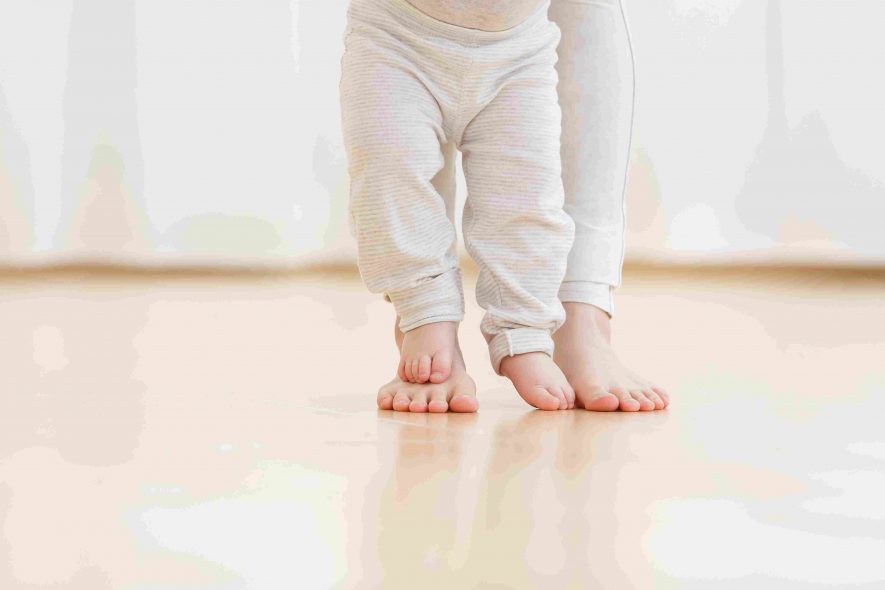
Encouraging your baby to take their first steps is one of the most rewarding things you can do as a parent. It is not only beneficial for their physical development, but it can also help with their cognitive abilities and social interactions. Moreover, this is also one of the milestones that most parents anxiously await.
There are plenty of ways to encourage your baby to walk. One simple way is to have lots of things around the house that your baby can explore, such as different textures, bright colors, and interesting shapes. You can also talk to your baby about what they are seeing and help them learn about their surroundings.
In this article, we’ll walk you through the things that will guide you about your baby’s walking journey.
At What Age Should Your Baby Start Walking?
Most babies start walking even before their first birthday, approximately around ten months old, though it can vary. Don’t worry if your kid starts walking past the typical age since every kid has their own pace of absorbing things. There will always be times when other babies walk sooner than your child.
There are cases where even before your child turns two, they may already be standing, walking, or even running. Most of the time, those kids tend to be the most confident and extroverted ones. But not all babies are born like that. Some kids might not want to stroll because they are more timid or introverted.
Different Stages of Learning How To Walk
Crawling
This procedure is seen when the baby starts showing signs of crawling at around seven months old. By this time, the baby can sit on the floor for short periods of time and feel confident about moving about on the ground.
Creeping
Babies could crawl or pull themselves forward to reach some goal. They may use their arms to help drag the rest of their body, considering that their leg muscles are still underdeveloped during this time.
Scooting
After learning how to crawl and creep, many babies move by sliding or gliding from one place to another. This can be seen by the way babies use their arms and legs, transforming an awkward waddling or sliding into a smooth commando-style crawl.
Cruising
The last stage before walking is called cruising. During this stage, their leg muscles are much stronger. This is the first time where your baby will be in a standing position and try to walk on their own by holding onto parts of furniture or people to serve as their guide.
How to Encourage Your Baby To Walk
The ideal strategy to get your baby to practice walking is to give them as much time as possible to learn by experiencing the world around them through their own body. It’s important to give your child time to explore their surroundings independently, so encourage them to spend lots of time without a stroller or carrier.
However, it is a general rule to never leave your baby without adult supervision at your house. Part of teaching your children about safety and how to behave is knowing where the risks are and teaching them how to avoid those areas.
Appliances that pose a risk should be secured with anchor screws. Furniture with rough edges, like a coffee table, should be covered with a cloth or self-adhesive products.
No Socks, Just Feet!
You can actually help your little one learn how to walk simply by standing barefoot on the ground. There are tiny muscles in our feet, and we can develop them by simply putting our weight on them by walking.
No other footwear, just bare feet! This will strengthen the little muscles in their feet and help them ‘feel’ the ground better.
The Power Of Toys
If you want your child to get up and walk around, it’s not a good idea to provide a steady circle of toys on the floor for them to play with. Rather, encourage movement by scattering toys around the room. Not very far from them that they give up trying. Just far enough to encourage walking to your baby and putting some effort into getting that push toy.
The Floor Is For Playing
For your toddler, playtime is a necessity. As they’re learning to walk, it can be a great way for them to practice their gross motor skills while you’re nearby. Physical activity helps avoid the risk of nervous system issues later on.
Rewards and Compliments
Keep an eye out for indicators that your baby is ready to take to the next level, and be sure to give them compliments and rewards for any progress made.
When you sense independence in their eyes, you can now enjoy the fruits of your, and your baby’s hard work.
Level Up Your Challenges
Once they’re already comfortable circling around, try walking them up & down a special ramp or uneven surfaces that may make them lose balance. This help build more stability in their skills. They’ll also be better prepared when they start walking across flat surfaces.

Essential Items To Help Your Baby Walk
Baby Knee Pads
Ashtonbee’s Baby Knee Pads are made for early cruisers. They are not just for crawling but for knee protection for your baby’s walking adventure. It prevents your baby from having bruises and scratches with its soft cushion. It also supports your baby’s knees.
Non-slip Socks
The floor of your house can be slippery depending on the material used, regardless if it’s dry or not. This can be unfavorable if you have a kid at home. Thankfully, Ashtonbee’s Non-Slip Baby Socks can help them explore without the fear of slipping or getting into any accident. It also comes with a cute ballet flat design, which would really fit your little cruiser!
Baby Foam Play Mat
Every baby needs its own place or “territory” where it can stay and play comfortably. Having a play mat is ideal since it gives you the benefit of secluding your baby’s play area from the rest of the house. It can also give your baby a sense of independence when they play in their zone.
Ashtonbee’s Foam Play Mat is made from safe and non-toxic materials and is also anti-microbial and hypoallergenic. You don’t need to worry about your baby’s health when they play or walk on these play mats.
Things That Can Hinder Them
Infant Walkers, Exersaucers, Jumpers
These equipment might seem like a good idea, but research suggests that when babies are on training wheels or walkers, it only increases the risk of injury.
Research shows that these baby “walking” aids can have negative effects on a baby’s development, causing them to be unfamiliar with their own body & movement. It gives them too much ankle support, which explains why it confuses the baby about its own movement.
There are different muscle groups that babies use with these devices than when walking, and they also rely on these devices to balance themselves.
Unnecessary Pressure
Don’t push children to do anything before they are ready. A child might not understand your intentions, and it could prove to be difficult for him or her in the long run. Let them take their time and find out what their real needs are, and you’ll get a happier & healthier baby as an end result.
Walking Peculiarities You Might Encounter (But Are Extremely Normal)
Tiptoeing
It’s normal for toddlers to be able to walk on tiptoes, but it’s always good to keep an eye out for red flags. However, there are some exceptions that you should take into consideration.
A tight heel or foot could mean your toddler needs extra stretching and care. If your child can’t push down their heel or is still walking on their tiptoes at two years old, bring them to a pediatrician.
Bilateral Symmetry
Feet may curve inward in some cases, known as bilateral symmetry. This happens during development in the womb and may take a while to adjust to its right position.
Bowed Legs
A baby may have slightly bowed legs after spending nine months cradled in your womb. Although they may remain until age 3, bowed legs usually disappear by approximately 18 months.
Pigeon-toe
There are a few reasons why your child’s feet may end up looking pigeon-toed like that. Fortunately, this condition is usually only temporary and should stop since the back of their knees usually turn outward on their first step. If not, make an appointment to visit their pediatrician.
When Should You Start Worrying If Your Toddler Isn’t Walking?
By the time a toddler is 4 or 5 years old, it’s often safe to say that they are already used to walking. By this point, if your child is still unable to walk, they may have experienced some Traumatic Brain Injuries (TBIs) or other conditions that can make walking difficult or impossible.
Consult a pediatrician as soon as you can to address this issue.
Provide Them With The Support They Need With Ashtonbee
The best effort to help your child in their walking journey is to provide them with all the support you can give, such as moral support and protective equipment to make sure they do not get hurt along the process.
There are different approaches, like something as simple as holding their hands. Others are more complicated such as using a walker. No matter what method you choose, always be passionate about it and be helpful in teaching your baby how to walk.
Try to keep a positive attitude and focus on the fun of it all. As the baby grows, continue providing opportunities for mobility and exercise. Want the best for your baby? Check out our other products!



